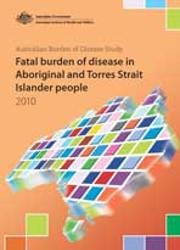Summary
This report presents estimates of fatal burden for Aboriginal and Torres Strait Islander Australians for 2010. Estimates of the 'gap' in fatal burden between Indigenous and non-Indigenous Australians are also reported, together with selected sub-national estimates (selected states and territories, remoteness and socioeconomic disadvantage).
Key findings
- There were around 2,950 deaths of Indigenous Australians in 2010, resulting in almost 100,000 years of life lost to premature mortality (YLL).
- In 2010, the rate of fatal burden experienced by Indigenous Australians was 2.6 times the rate of fatal burden experienced by non-Indigenous Australians.
- Injuries and cardiovascular diseases contributed the most fatal burden for Indigenous Australians (22% and 21% respectively), followed by cancer (17%), infant and congenital conditions (10%), gastrointestinal diseases (6%) and endocrine disorders (5%). These disease groups accounted for 82% of all Indigenous YLL in 2010.
- Indigenous males had a higher proportion of YLL from injuries than Indigenous females (representing 26% compared to 16% of total YLL). In contrast, cancer represented a higher proportion of total YLL for Indigenous females than for Indigenous males (21% compared to 15% respectively).
- Deaths in infants (under 1 year) contributed the most to Indigenous YLL (12% for males and 11% for females). This reflects the influence of age at death on the measure of fatal burden. The remaining majority of fatal burden in the Indigenous population is in the middle aged; however, the highest YLL rates per 1,000 population are in the older age groups (aged 70 and over), reflecting higher death rates in these age groups.
- Infant and congenital conditions accounted for the majority of the fatal burden among Indigenous infants (80% for males and 85% for females). Injuries accounted for the majority of fatal burden among those aged 1-34. Cardiovascular diseases and cancer were the two biggest contributors to total YLL for Indigenous people aged 45 and over. Endocrine disorders (which include diabetes) were also in the top 5 causes of fatal burden for Indigenous people aged 45 and over.
- The diseases contributing most to the gap in fatal burden between Indigenous and non- Indigenous Australians were cardiovascular diseases (responsible for 27% of the gap), cancer (15%), injuries (14%) and endocrine disorders (10%). Together, these disease groups accounted for almost two-thirds of the gap in fatal burden of disease in 2010.
- Endocrine disorders, and kidney and urinary diseases, had the highest relative disparities in fatal burden, with YLL rates for Indigenous Australians being 8 and 7 times the rates for non-Indigenous Australians for these 2 disease groups respectively.
- Rates of fatal burden among the Indigenous population were highest in the Northern Territory and Western Australia (of the 4 jurisdictions for which YLL estimates are reported: New South Wales, Queensland, Western Australia and the Northern Territory); and were higher in Remote and Very remote areas compared to Major cities and regional areas. Indigenous YLL rates were highest in areas where the Indigenous population was most socioeconomically disadvantaged and fell with decreasing levels of disadvantage.
Preliminary material: Acknowledgments; Abbreviations; Symbols; Preface
1 Introduction
- What is burden of disease?
- Previous burden of disease studies
- Australian Burden of Disease Study 2011
- Purpose and structure of this report
2 Methods, data sources and data quality
- Years of life lost
- Data sources and inputs
- Methods for redistribution of deaths
- Methods specific to Indigenous fatal burden estimates
3 National results: Indigenous YLL
- Overall Indigenous fatal burden by age and sex
- Indigenous fatal burden by disease group
- Do the leading causes of fatal burden differ by sex?
- Do the leading causes of fatal burden differ by age group?
- Age patterns in YLL for selected disease groups
4 National results: Mortality gap
- What is the overall gap in fatal burden?
- Which age groups contribute the most to the mortality gap?
- What diseases are the leading contributors to the mortality gap?
- Do the leading contributors to the mortality gap differ by age?
- Do the leading contributors to the mortality gap differ by sex?
5 Sub-national results
- 5.1 State/territory
- 5.2 Remoteness
- 5.3 Socioeconomic disadvantage
6 International comparisons
- 6.1 New Zealand Burden of Diseases, Injuries and Risk Factors Study, 2006-2016
- 6.2 Results
7 Discussion
Key findings and policy implications
Appendixes
Appendix A: Burden of disease studies
Appendix B: Data sources and standard life table
Appendix C: Measures of socioeconomic disadvantage
Appendix D: Cause list and redistribution
Appendix E: Methods for adjusting Indigenous mortality data
Appendix F: Measuring the gap
End matter: Glossary; References; List of tables; List of figures; List of boxes



